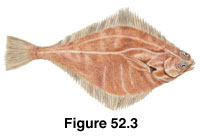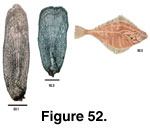 Description
Description
Hippoglossus stenolepis
(Pacific Halibut)
(Other common names: Halibut, Northern Halibut, Right Halibut)
Figure 52.3
 Description
DescriptionLength: 267 cm (males generally smaller than females).
Mouth: large, terminal; wide gape; nearly symmetrical; directed forward and up; upper jaw extends to mid orbit of lower eye; lower jaw protrudes; teeth conical and well developed with a double row in the upper jaw and a single row in the lower jaw.
Body: caudal peduncle compressed; caudal fine slightly forked; interorbital space narrow and concave; lateral line highly arched over pectoral region; lateral line dorsal branch absent.
Color: gray marble to dark brown on eyed side; white on blind side.
Depth: up to 1100 m; mainly between 55-422 m; young in shallower waters, move deeper as they age.
Habitat: variety of substrates.
Season: spawn in winter (November-January) in deep waters; mature adults can have significant migrations.
Diet: crustaceans, molluscs (e.g., clams, squid, octopus), and fish.
Predators: not determined.
Distribution: southern California to the Bering Sea to the Sea of Japan.
 Scale Description
Scale DescriptionType of Scale: cycloid on both sides (Batts, 1964).
Relative Scale Size: small.
Position of Scales on Body: approximately 150 scales along the lateral line canal; imbricated (Hart, 1973).
Overall Scale Shape: ovoid with elongated lateral fields with a narrow and short posterior field. Area of anterior field larger than area of combined lateral fields (Batts, 1964).
Focus and Circuli: focus is approximately one-fourth to one-fifth of the total scale length from the edge of the posterior field. The circuli can be followed but can appear somewhat broken. Circuli are more dense in the lateral fields than the anterior field and are irregularily spaced in the anterior field (Batts, 1964).
Radii: numbers are variable and not diagnostic. The radii are primarily in the anterior field (radii not present in all fields, Batts, 1964). The outer edge of the anterior field is convex and scalloped. Intermarkings absent (Batts, 1964).